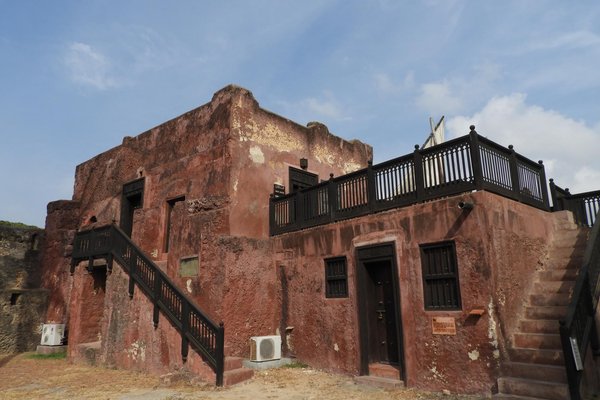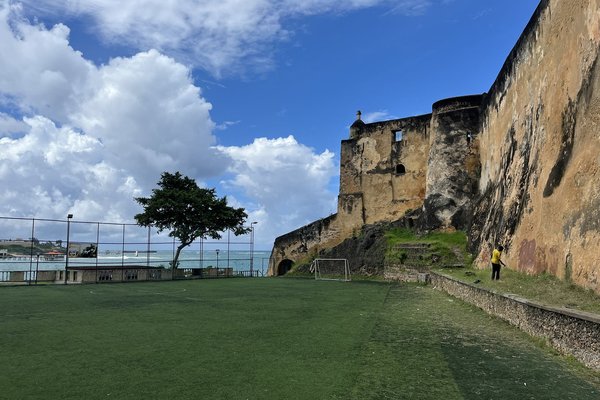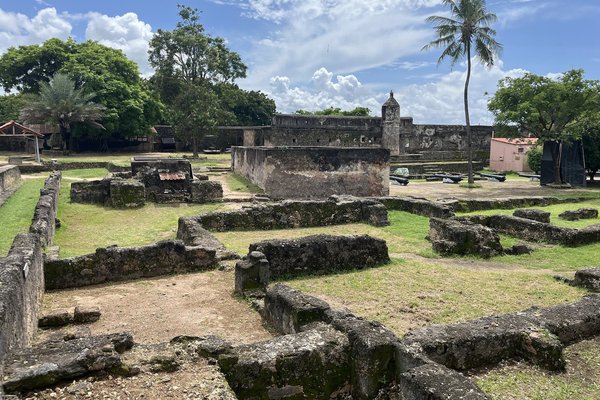Kenya
Fort Jesus
Fort Jesus, Mombasa is a fort built by the Portuguese to control the Indian Ocean trade. It later came under Arab, Swahili and English control.
The fortress was the first European-style fort constructed outside of Europe, a new type of fortification designed to resist cannon fire and built reflecting the Renaissance ideal. Today, it is one of the finest surviving examples of 16th-century Portuguese military architecture, which was influenced and changed by both Omani Arab and British colonial powers.
Community Perspective: Worth about an hour. Your only choice to make is whether to hire a guide or not.
Site Info
Official Information
- Full Name
- Fort Jesus, Mombasa (ID: 1295)
- Country
- Kenya
- Status
-
Inscribed 2011
Site history
History of Fort Jesus
- 2011: Advisory Body overruled
- ICOMOS recommended Deferral - proposal needed better justification of OUV, comparative analysis and buffer zone. Nigeria proposed inscription - passed nem con!
- 2011: Inscribed
- Inscribed
- 2010: Referred
- 2008: Incomplete - not examined
- Type
- Cultural
- Criteria
- ii
- iv
Links
- UNESCO
- whc.unesco.org
All Links
UNESCO.org
- whc.unesco.org — whc.unesco.org/
News Article
- Jan. 17, 2018 the-star.co.ke — Sh498m Fort Jesus wall to stop erosion of World Heritage Site
- Oct. 3, 2016 geeskaafrika.com — Fort Jesus to get a $3.9M facelift
- May 9, 2015 allafrica.com — Vandals Deface Fort Jesus Heritage Site
- April 15, 2014 standardmedia.co.ke — Fort Jesus continues to register dwindling numbers of visitors
Community Information
- Community Category
- Secular structure: Military and Fortifications
Travel Information
Recent Connections
-
Mentioned in Paradise Lost
"Mombaza, and Quiloa, and Melind." Cite…
-
Slavery
Mombasa played an important part in the… -
Foreigner prices
1,200 Ksh for non-residents, 200 Ksh fo…
Connections of Fort Jesus
- Geography
-
-
Swahili culture
Although of Portugese origin, it has some Swahilian touches: "Decorative elements included Swahili kidaka (plastered wall niches) that ran along the east wall at a height of 1.75 meters from the floor." (link)See archnet.org
-
- Trivia
-
-
Built or owned by Portuguese
"Fort Jesus, Mombasa, was erected in 1593-96 to the designs of Giovanni Battista Cairati by the Portuguese when they gained control over Mombasa" (AB ev) -
Built or owned by Omanis
"Having become aware of declining Portuguese control, the Omani raided their possessions on the East African coast from 1652 onwards and repeated attacks were launched until 1696 when the Omani Arabs besieged Fort Jesus, Mombasa, and eventually drove out the Portuguese." (AB ev)
-
- Architecture
-
-
Coral Masonry
Part of the original construction material (AB ev) -
Italian Architects outside Italy
"Fort Jesus, Mombasa, was erected in 1593-96 to the designs of Giovanni Battista Cairati ... Cairati was an Italian military architect and engineer who designed several fortresses for the Portuguese colonies in Asia" (AB ev) -
Renaissance
Described as Renaissance military architecture (AB ev)
-
- World Heritage Process
- Human Activity
-
-
Sea Ports
Because of its strategic location, Mombasa grew in importance over the centuries and soon became a major trading port ... Fort Jesus, Mombasa, was erected .. to protect its port" (AB ev) -
Slavery
Mombasa played an important part in the Indian Ocean Slave Trade, and the strategic Fort Jesus was involved. It is also believed that enslaved persons were kept at the Fort, both by the Omani and the British. -
Geoglyphs
The Fort was given a form that was roughly human ... the image of the martyred Christ has also been read in the plan of the fort (AB ev)
-
- Constructions
-
-
Cisterns
"The fortress included facilities such as a chapel, a cistern, a well, and the Captain’s house, but among these only the cistern and an L-shaped building survive." (AB ev) -
Prison
Under British rule the Fort was converted to a prison until 1958 (AB ev) -
Moats
"includes the fort's moat" (Brief Description)
-
- WHS on Other Lists
-
-
World Monuments Watch
Swahili Coast Heritage Sites, Comoros, Kenya, Mozambique, Tanzania (2025)See www.wmf.org
-
- Timeline
-
-
Built in the 16th century
built by the Portuguese in 1593-1596
-
- Visiting conditions
-
-
Foreigner prices
1,200 Ksh for non-residents, 200 Ksh for Kenyans (2025)
-
- Literature & Film
-
-
Mentioned in Paradise Lost
"Mombaza, and Quiloa, and Melind." Cited as a "maritime king," this entry refers to the strategic island hub that Milton recognized as a key pillar of coastal authority. Mombasa's Coastal History
-
News
- the-star.co.ke 01/17/2018
- Sh498m Fort Jesus wall to stop ero…
- geeskaafrika.com 10/03/2016
- Fort Jesus to get a $3.9M facelift
- allafrica.com 05/09/2015
- Vandals Deface Fort Jesus Heritage…
Recent Visitors
Visitors of Fort Jesus
- Albert
- Alberto Rodriguez Gutierrez
- Alex Marcean
- AmyAbroad
- amychemu
- Ask Gudmundsen
- Aspasia
- Atila Ege
- Carlos Sotelo
- cwthong
- David Marton
- Dolemite92
- DouglasR
- Els Slots
- Eric Lurio
- Erik Jelinek
- Eva Kisgyorgy
- fedemarch92
- Harald T.
- Harry Mitsidis
- Iain Jackson
- Jon Opol
- Kjlauer
- Knut
- ko9757
- Krijn
- Kurt Lauer
- Luis Filipe Gaspar
- marcel staron
- Martin
- Michael Ayers
- Michael Novins
- Mihai Dascalu
- MoPython
- Morodhi
- Naim Y
- Nihal Ege
- palka25
- Patrik
- Paul Schofield
- Peltzi
- Randi Thomsen
- Roger Ourset
- Roman Bruehwiler
- shoaibmnagi
- Solivagant
- Stanislaw Warwas
- Svein Elias
- Szucs Tamas
- Thomas Buechler
- Thomas van der Walt
- Vanessa Buechler
- Vernon Prieto
- Zoë Sheng
Community Reviews
Show full reviews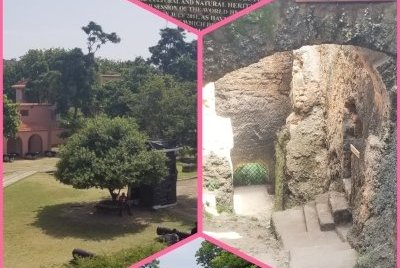
Oh jeez, they named a fort after Jesus? Well unlike the prophet the fort is not special, at all. So the unique points are that it was numero uno European (Portuguese) fort in the area of this style, second being that it was taken over by the Omanis. You can get around the entire fort within 20 minutes as it's so small. If you want to hire a guide they will approach you as you get to the entrance already and the ticket check lady asked me again as I entered. I think there are only two places that they would be useful. 1. The great wall painting and I would say that IS the best about the fort if not for it being remade in the 60s. Here there would be explanations to appreciate it more. Second would be arch passage and rooms below because by itself it's nothing to look at and I overheard the guides chat about it a lot. The main barracks are currently under renovation so I think they will add a lot to see later. There is also a small Omani museum but it's not really related to the fort (and talks about heritage sites in that country instead) as well as a large whale bone collection which again doesn't apply to the fort.
Even though I had all morning planned for the sightseeing it was already done within an hour. Can't really recommend it.
Keep reading 0 comments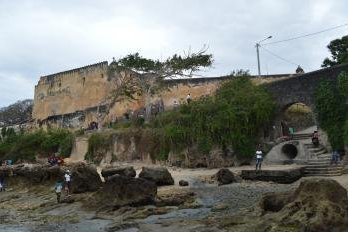
In August 2016, I flew from Zanzibar to Mombasa, where I stayed at the Castle Royal Hotel, which dates from 1909 and is centrally located between the Moi Avenue tusks and Mombasa Old Town. Along with a guide from Diani Tours (http://www.dianisafaris-kenya.com), I walked from my hotel to the historic spice market (one of the most photogenic in East Africa) and then through the Old Town, where I visited the White House (which served as the first U.S. consulate in Kenya from 1915 - 1918), to Fort Jesus, a Portuguese fort built between 1593 and 1596. Based on what I had read, I thought it was prudent to arrange for a local guide, although the area seemed safe, at least for a daylight meandering -- still, it was helpful to have a guide to navigate through the labyrinthine streets from the spice market to Fort Jesus.
Keep reading 0 comments
